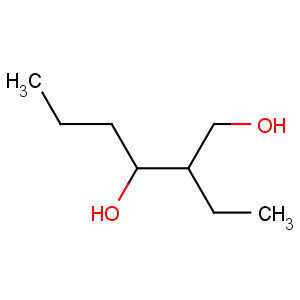Title: Ethohexadiol
CAS Registry Number: 94-96-2
Synonyms: 2-Ethyl-1,3-hexanediol; 2-ethyl-3-propyl-1,3-propanediol; octylene glycol
Trademarks: 6-12 (Union Carbide)
Molecular Formula: C8H18O2
Molecular Weight: 146.23
Percent Composition: C 65.71%, H 12.41%, O 21.88%
Literature References: Prepn: Kulpinsky, Nord,
J. Org. Chem. 8, 256 (1943); B. G. Wilkes,
US 2407205 (1946 to Carbide & Carbon Chemicals). Activity: P. Granett, H. L. Haynes,
J. Econ. Entomol. 38, 671 (1945); W. V. King,
ibid. 44, 339 (1951); B. V. Travis, C. N. Smith,
ibid. 428. As an additive in mosquito repellant: W. G. Reifenrath, L. C. Rutledge,
J. Pharm. Sci. 72, 169 (1983). Toxicity study: B. Ballantyne
et al., Vet. Hum. Toxicol. 27, 491 (1985).
Properties: Colorless, odorless, slightly viscous liq. d2020 0.9422. d422 0.9325. bp760 244.2°; bp50 163°; bp10 129°; bp3 102°; bp0.5 94-96°.
nD22 1.4530. Flash pt 260°F. Vapor pressure at 20° <0.01 mm. Abs viscosity: 271 cP. Soly in water 0.6% w/w; soly of water in 2-ethyl-1,3-hexanediol 10.8% w/w; sol in ethanol, isopropanol, propylene glycol, castor oil. LD50 in male, female rats (ml/kg): 9.85, 4.92 orally (Ballantyne).
Boiling point: bp760 244.2°; bp50 163°; bp10 129°; bp3 102°; bp0.5 94-96°
Flash point: Flash pt 260°F
Index of refraction: nD22 1.4530
Density: d2020 0.9422; d422 0.9325
Toxicity data: LD50 in male, female rats (ml/kg): 9.85, 4.92 orally (Ballantyne)
CAUTION: Little or no skin absorption; ingestion causes CNS depression.
See: Clinical Toxicology of Commercial Products, R. E. Gosselin
et al., Eds. (Williams & Wilkins, Baltimore, 5th ed., 1984) Section II, pp 347.
Use: Insect repellent.

